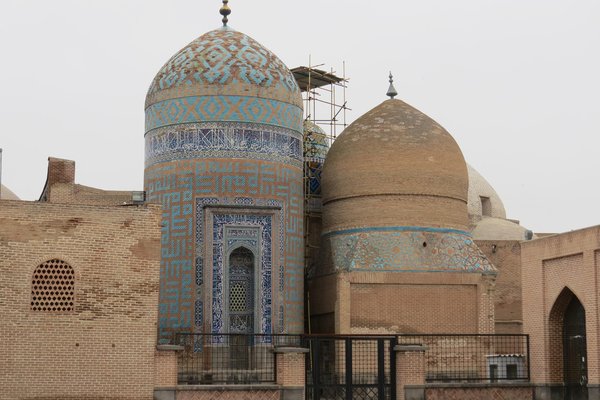Iran
Safi al-Din Ensemble in Ardabil
The Sheikh Safi al-Din Khanegah and Shrine Ensemble in Ardabil is a Sufi spiritual retreat dating from the 16th-18th centuries.
It is the burial site of Safi al-Din Ardabili, the eponymous founder of the Safawiyya order of Sufism, and an important site of pilgrimage. The complex is a fine example of Ilkhānid and Timurid- influenced Iranian architecture and one of the most beautiful of all monuments from the Safavid era. It also served social and eductional purposes, and includes a library, a mosque, a school, a hospital, kitchens, a bakery and some offices.
Community Perspective: The interior of the shrine is the best part, with blue and gold ornamented tiles and overall delicate decoration. The Porcelain Room, with niches filled with precious Chinese porcelains, is one of its highlights.
Site Info
Official Information
- Full Name
- Sheikh Safi al-Din Khanegah and Shrine Ensemble in Ardabil (ID: 1345)
- Country
- Iran
- Status
-
Inscribed 2010
Site history
History of Safi al-Din Ensemble in Ardabil
- 2010: Inscribed
- Inscribed
- Type
- Cultural
- Criteria
- i
- ii
- iv
Links
- UNESCO
- whc.unesco.org
- Official
-
- itto.org — Ardebil
- Related
-
- archnet.org — The shrine described by ArchNet
All Links
UNESCO.org
- whc.unesco.org — whc.unesco.org/
Official Website
- itto.org — Ardebil
Related Resources
- archnet.org — The shrine described by ArchNet
Community Information
- Community Category
- Religious structure: Islamic
Travel Information
Red Zone Travel Advisory
Recent Connections
-
Perfect Inscriptions
2010 -
Red Zone Travel Advisory
Iran fully off-limits -
Untranslated Toponyms
A khanqah (Persian: خانقاه) or khangah …
Connections of Safi al-Din Ensemble in Ardabil
- History
-
-
Silk Roads
(Near) Classic Land Route; in ICOMOS thematic study but no details on role or function
-
- Architecture
-
-
Timurid Architecture
"The architectural spaces and features of the nominated property have integrated influences of the Ilkhānid and Timurid periods" (OUV) -
Domes
Several of the tombs -
Octagons
Jannatara, a large octagonal structure covered with a shallow dome that projects into the Shahidgah cemetery to its north (Archnet) -
Muqarnas
-
Brick architecture
-
Glazed tiles
Tomb Tower of Shaykh Safi -
Square Kufic
The Allah Allah dome part of the Sheikh Safi Mausoleum
-
- World Heritage Process
-
-
Perfect Inscriptions
2010
-
- Religion and Belief
-
-
Sufism
-
Notable mosques
-
Shia Islam
Linked to the Safavid conversion of Iran to Shia Islam; symbols include for example a 12-sided pool (which symbolizes the 12 Shiite Imāms) (nom file)
-
- Constructions
-
-
Cisterns
-
Hospitals
The Ensemble included the hospital Sharbat Khānā or Shafā Khāna. (AB ev) -
Caravanserai
Remains of 2 Chilakhanas - "the Chilakhana had a total of forty rooms and served both as a hostel and trading centre" (ArchNet) -
Cenotaph
wooden cenotaph of Shah Isma'il (Archnet) -
Cemeteries
-
Tombs
-
Mausolea
-
- WHS on Other Lists
-
-
Memory of the World
Documents of the Shaykh Safī-al-Dīn Ardabīlī Shrine (952 to 1926 CE) (2023)
-
- Timeline
-
-
Built in the 16th century
The Sheikh Safi al-Din ensemble is a prototype and an outstanding example of a 16th century religious complex (AB ev)
-
- Science and Technology
-
-
Libraries
"Sheikh Safi al-din ensemble consists of a range of buildings including the tomb, Khānegāh, the library, the mosque, the school...This huge building ..was called Jannat Sara, and served as the library. In the Islamic [Islamia] encyclopedia, there is an account of the greatness of the library of Sheikh Safi al-din. Today, nothing of the library is left though it has once been the largest library in Iran.....At the time of occupation of Ardabil by the Russians (1827), the religious and cultural texture of the city suffered grave losses. The library was sent to Saint Petersburg by General Peskevich, and was attached to the library of that city". Nom File - this describes how Russian troops "diverted" to Ardabil "It was only the library of Sheikh Safi al-din Ardabili's shrine which held numerous books and precious manuscripts ..... (so) though Ardabil was not on their route, and its occupation would cost expenses and efforts to them ... a group of soldiers were dispatched to Ardabil to besiege the library and take control of it". This Russian article of 1996 claims that the library was actually "purchased" and selected "with the assistance of the mosque's mufti" (see link)
-
- Visiting conditions
-
-
Red Zone Travel Advisory
Iran fully off-limits
-
- WHS Names
-
-
Untranslated Toponyms
A khanqah (Persian: خانقاه) or khangah (Persian: خانگاه; also transliterated as khankah, khaneqa, khanegah or khaneqah; also Arabized hanegah, hanikah, hanekah, khankan), also known as a ribat (رباط), is a building designed specifically for gatherings of a Sufi brotherhood or tariqa and is a place for spiritual practice and religious education" (Wiki)See en.wikipedia.org
-
Microcosm
"Sheikh Safi al-Din Khānegāh and Shrine Ensemble was built as a small microcosmic city with bazaars, public baths, squares, religious buildings, houses, and offices." (OUV)
-
News
No news.
Recent Visitors
Visitors of Safi al-Din Ensemble in Ardabil
- Afshin Iranpour
- Alexander Barabanov
- Ask Gudmundsen
- Atila Ege
- BaziFettehenne
- Bernard Joseph Esposo Guerrero
- Els Slots
- Erik Jelinek
- Fan Yibo
- henryjiao18
- Ivan Rucek
- Jean Lecaillon
- Jonas Kremer
- Joyce van Soest
- Knut
- Maciej Gil
- Martin
- Martina Rúčková
- Roman Bruehwiler
- Solivagant
- Szucs Tamas
- Thomas Buechler
- Wojciech Fedoruk
- Zoë Sheng
Community Reviews
Show full reviews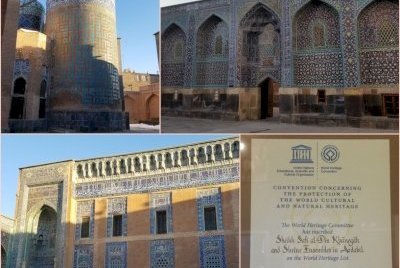
My last Iranian WHS to visit and I almost missed it. The entrance to the site is not clear. I walked past it and reach what appeared on the map to be the tomb with a tiny sign pointing left to where I came from, but actually it looked more like it was pointing at some construction and I figured "oh no, another closed WHS in winter". So I walked into the next alley, nothing. Then I turned into the courtyard on the way back which is actually the archaeological museum and already closed. The young guard led me to the right place in the OTHER courtyard.
I was immediately taken by the nice garden and outer architecture but it doesn't quite prepare you for what you see inside. The tomb is marvelous yet the highlight is the next, bigger room, with your eye exploring each niche of the prayer rooms. Pictures are not allowed inside yet a friendly nod allowed me to snap the inscription certificate, but unlike other reviews I didn't have the encourage to pull out my camera when the staff is not looking. I spent half an hour in the area, more than most people probably do, making two trips through the rooms.
Surely one of the highlights in Iran.
Keep reading 0 comments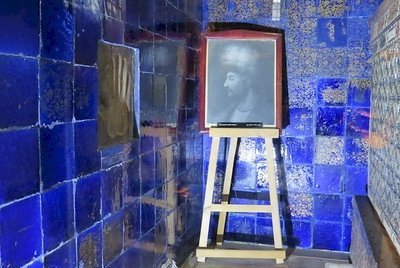
The Sheikh Safi al-Din Khanegah and Shrine Ensemble in Ardabil is a 16th-century Iranian Sufi sanctuary with an especially cumbersome name. It is shortened in the nomination file and at the site itself to ‘SKSEA’. I had it registered on this website under ‘Ardabil’, but to be clear: it’s not the whole city that is included in the List – only a specific religious ensemble.
Ardabil was the first city that I visited during my Iran trip. It is a sizeable provincial capital in the far northwest of the country. I arrived here from Azerbaijan via the Astara border post, somewhat of a back door to the Islamic Republic of Iran. The Sufi complex lies in the center of town. It doesn’t look particularly noteworthy from the street. Most of it is hidden behind brick walls. A smallish gate, decorated with distinctive glazed tiles, houses the entrance.
I arrived early in the morning, and there were hardly any other visitors. Via the garden, there’s another gate to tackle, and then the site opens up to you. The courtyard of the religious complex is surrounded on all four sides by buildings that are covered with blue tiles with green and yellow accents. This was my first example of Iranian architecture and I immediately knew it was a wise decision to come here.
The three towers, that hold the mausoleums of the most important Sufi’s that are honoured here, are almost overlooked among all the splendour. Yet they are …
Keep reading 0 comments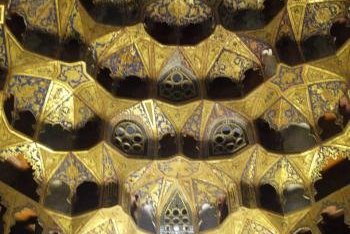
Safi ed-Din Shrine is seemingly one of the least visited WHS, that is reaaly surpising given that Ardabil is a big city easy to reach, and the place itself is really rewarding. Once you are in Iran (that is a much less difficult task than you think) it is easy to get to Ardabil. It is linked to all major cities, or directly either through Tabriz, that is only two hours on the motorway. (Less if you have a better car than we had.)
And once you are in Ardabil you cannot miss the Shrine -it is right in the middle of the city centre. From outside it does not offer too much - a regular blue-tiled religious building that you can see every now and then in Iran. But as you enter - there is an entrance fee for foreigners - with every step it is getting to be more and more miraculous.
Safi ed-Din is one of the most impoartant figures of the iranian history. His descendats, the Safavids, shaped iran to what it is now. They introduced the Shiite form of Islam, that is now the state religion of the country. Sheikh Safi-ad-din Is'haq Ardabili was the Kurdish eponym of the Safavid dynasty, founder of the Safaviyya order, and the spiritual heir and son in law of the great Sufi Murshid (Grand Master) Sheikh Zahed Gilani, of Lahijan in Gilan province in northern Iran. Most of what we know about him comes from the Safvat as-safa, a …
Keep reading 0 comments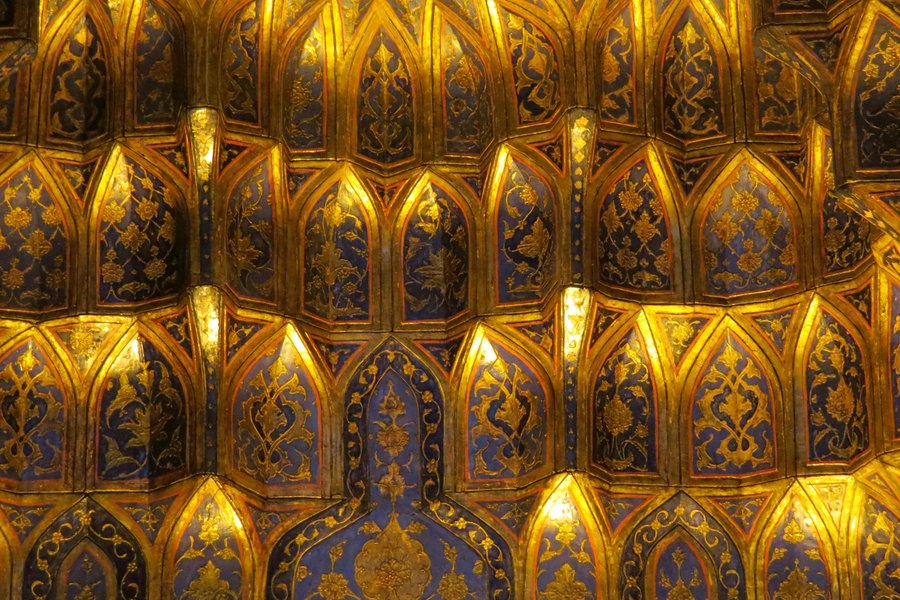
February 2012, its the moment of decision. To go or not to go to Iran. I had booked this trip a while ago but did not anticipate that the political situation was so tense at this time. Israel is assumed to be ready to bomb the nuclear sites in Iran as early as April and the US could be dragged in via the Straits of Hormuz etc. Added to the fact that the US does not have an embassy in Iran makes it even more tricky.
In the end I decided that March is a window of calm and off we went. This is not a forum for discussion on politics but I am now convinced that religion and politics should never be in the same room. Political power through religion is extremely dangerous.
Ardebil has been a 'pilgrimage' goal of mine for over 20 years because of the collection of Chinese porcelains (to be discussed later). It happens to be the mausoleum of a Sheikh Safi-Od-Din. He was credited of turning Iran away from Sunni Islam to Shite Islam and so the shrine is a pilgrimage site to many religious people in Iran.
The complex is not huge but the decoration is delicate and beautiful. It was built by Safi-Od-Din's grandson to honor his grandfather during the Safavid period and its importance grew over time. The entry is through a formal garden complex over 100 meters and through a door into the courtyard surrounded by facades of blue tiled …
Keep reading 0 comments
